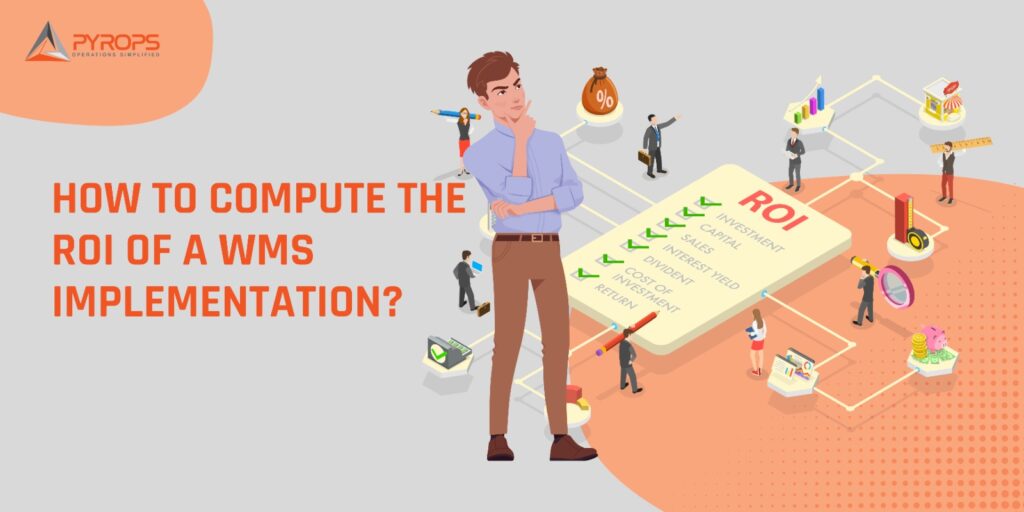Implementation of a Warehouse Management System (WMS) is often seen as a strategic imperative. A well-executed WMS software can significantly enhance warehouse efficiency, accuracy, and customer satisfaction.
A Warehouse management system is software that helps warehouses run more efficiently. It automates tasks like inventory tracking, order picking, packing, and shipping. This reduces errors and improves productivity.
Significance of ROI in Warehouse Management Systems
Warehouse Management System ROI (WMS ROI) is a crucial financial metric that enables businesses to assess the effectiveness of their WMS implementation. It evaluates the financial gains, including cost reductions, operational streamlining, and revenue expansion, in comparison to the total ownership cost of the system. A higher ROI percentage signifies a more successful implementation
However, making a case for the investment in a warehouse management software requires more than just a financial projection. It necessitates a comprehensive understanding of how to compute Return on Investment (ROI) that encompasses both the direct measurable benefits and the indirect, often intangible advantages.
The Direct Measurable Benefits
1. Improved Inventory Accuracy
A WMS provides real-time visibility into inventory levels, locations, and movements. By reducing discrepancies, misplacements, and stockouts, businesses can decrease carrying costs and increase working capital turnover.
2. Enhanced Labor Productivity
Efficient task management, optimized picking routes, and reduced manual data entry lead to higher worker productivity. This can translate directly into cost savings, as fewer man-hours are required to complete warehouse operations.
3. Reduced Error Rates
Automation and real-time tracking systems in WMS solutions reduce errors in order picking, packing, and shipping. Fewer errors mean fewer returns, less rework, and improved customer satisfaction.
4. Faster Order Fulfillment
With WMS implementation, orders can be processed and shipped faster, leading to shorter order-to-delivery cycles. This can result in higher sales and customer loyalty.
5. Improved Space Utilization
WMS optimizes storage, ensuring that the available space is utilized efficiently. This can reduce the need for additional warehouse space, which is a direct cost savings.
The Indirect, Intangible Benefits
1. Improved Customer Satisfaction
While difficult to quantify, satisfied customers are more likely to place repeat orders and become brand advocates. The positive impact on customer loyalty can significantly contribute to long-term revenue growth.
2. Competitive Advantage
A well-implemented WMS can set your business apart from competitors. Faster order processing, accurate inventory information, and on-time deliveries can attract new customers and retain existing ones.
3. Scalability
WMS solutions are designed to accommodate business growth. As your operations expand, the WMS can scale seamlessly, reducing the need for costly system replacements.
4. Data-Driven Insights
WMS generates a wealth of data that can be leveraged for continuous improvement. Insights into warehouse operations can lead to process enhancements and cost reductions over time.
5. Risk Mitigation
By reducing errors and improving inventory accuracy, a WMS helps mitigate the risks associated with stockouts, overstocking, and compliance issues. This can safeguard your brand’s reputation and minimize potential financial losses.
WMS ROI: What it is & How to calculate it?
ROI, or Return on Investment, serves as a pivotal metric in assessing the effectiveness of any business venture, including the adoption of a Warehouse Management System (WMS). By computing the ROI associated with your WMS software, you can ascertain the value of your investment and whether it has yielded the anticipated returns.
Calculating ROI
While the direct measurable benefits of a WMS implementation are relatively straightforward to quantify, assessing the indirect benefits requires a more nuanced approach. To calculate the comprehensive ROI, consider the following steps:
Define Key Performance Indicators (KPIs): Start by identifying the KPIs that align with your business goals. These could include metrics like order accuracy, order cycle time, and customer satisfaction.
Baseline Assessment: Measure your current performance in these KPIs before WMS implementation. This establishes a baseline against which you can later compare post-implementation results.
Post-Implementation Measurement: After WMS implementation, track the same KPIs over a specific period. Compare the results to the baseline to determine improvements.
Monetize Indirect Benefits: Assign monetary values to the indirect benefits wherever possible. For example, customer satisfaction improvements can lead to increased revenue through repeat business.
Calculate ROI: Use the following formula to calculate ROI:
ROI (%) = [(Net Benefits / Investment Costs) * 100]
Consider Payback Period: Determine how long it will take for the benefits to recoup the initial investment. A shorter payback period indicates a quicker return on investment.
Conclusion
Calculating the ROI of a WMS implementation goes beyond absolute financial outlay. It requires a holistic approach that encompasses both direct and indirect benefits.
While the direct benefits are relatively easy to quantify if you have a clear baseline, the indirect advantages can be just as impactful, if not more so, in the long run.
By carefully considering and measuring these indirect benefits, businesses can make a compelling case for WMS investment that extends far beyond the balance sheet.
If you’re considering the WMS implementation in your warehouse and wish to assess its ROI, please reach out to us. Our team will analyze your requirements and develop customized solutions to align with your storage facility’s needs.
Read more: How is dark store fulfillment different from regular E-commerce fulfillment







